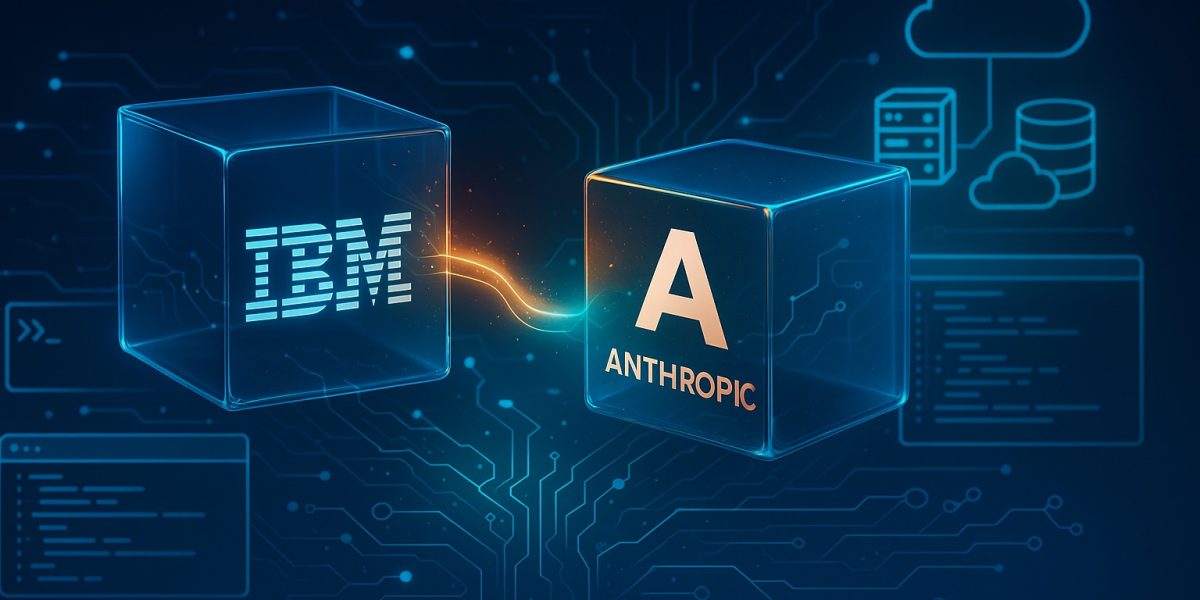IBM and Anthropic just unveiled a partnership that puts Claude AI directly inside IBM’s software development environment. Early testing numbers suggest this could meaningfully change how enterprise developers work—6,000 IBM employees who’ve been trying the system reported productivity jumping by 45% on average.
The companies made the announcement today at IBM’s TechXchange 2025 conference in Orlando, centering around something they’re calling Project Bob—an AI-first development environment currently in closed preview. The name’s a bit underwhelming, but what it does sounds genuinely useful for enterprise development teams dealing with massive, complex codebases.

Why This Matters for Enterprise Development
Project Bob isn’t trying to be another coding assistant that autocompletes your functions. It’s built specifically for the messy reality of enterprise software—legacy systems, enormous repositories, and the kind of large-scale modernization projects that take months or years when done manually.
The platform maintains full repository context throughout your entire editing session and handles complex enterprise-specific tasks. We’re talking about automating transitions from ancient frameworks like Struts to modern platforms like React and Angular—the kind of migration work that typically requires entire teams and careful planning to avoid breaking production systems.
It coordinates multiple large language models to tackle these complicated jobs, including automated Java updates, framework migrations, and security hardening across vast amounts of code. Language support covers Java, JavaScript, Python, Go, C#, Rust, PHP, and Kotlin.
“IBM has been the backbone of enterprise technology for decades because we understand what it takes to deploy solutions in mission-critical environments and at enterprise scale,” said Dinesh Nirmal, IBM’s Senior Vice President for Software. “This partnership expands our software portfolio with leading AI capabilities while maintaining the governance, security, and reliability our clients expect.”
That last part about governance, security, and reliability isn’t just marketing speak—it highlights the real difference between consumer coding tools and what enterprises actually need. When you’re modifying code that runs critical business operations, you can’t just hope the AI got it right. You need audit trails, security scanning, and the ability to roll back changes when something inevitably breaks.
What Makes This Different From GitHub Copilot or Other Tools
Most AI coding assistants focus on individual developers writing new code. You type a comment describing what you want, and the AI suggests implementation. That’s helpful, but it doesn’t address the bigger challenge enterprises face: maintaining and modernizing millions of lines of existing code written by developers who may no longer work at the company.
Project Bob tackles this by understanding context across entire enterprise repositories. When you’re making changes, it knows about dependencies, design patterns used elsewhere in the codebase, security policies, and architectural decisions. This comprehensive awareness helps prevent the “it works in isolation but breaks everything else” problem that plagues large-scale refactoring efforts.
The 45% productivity increase IBM’s reporting comes from internal testing with 6,000 employees—a substantial sample size that suggests the benefits aren’t just flukes or cherry-picked examples. Of course, these are IBM employees testing an IBM product, so some skepticism about generalizability is warranted. Real-world results with external customers will be the true validation.
Contributing to AI Standards Development
Beyond just integrating Claude into IBM’s tools, the partnership includes collaborative work on standards for enterprise AI agents. IBM and Anthropic published guidance titled “Architecting Secure Enterprise AI Agents with MCP,” focusing on the agent development lifecycle for designing and managing corporate AI systems.
IBM committed to contributing enterprise-grade resources to the Model Context Protocol community, including best practices and reference architectures developed from deployment experience across thousands of customer environments. This matters because enterprises adopting AI agents need proven patterns and architectures rather than starting from scratch.
Mike Krieger, Anthropic’s Chief Product Officer, emphasized the partnership’s focus on trust and dependability. “Claude has become the leading AI for developers at the world’s largest companies because of our focus on safety and reliability,” he said. “This partnership with IBM will allow us to bring that same level of responsibility to even more enterprise teams while building open standards that make AI agents genuinely useful for business.”
The emphasis on open standards suggests both companies recognize that proprietary, locked-in approaches won’t work for enterprise AI adoption. Customers want flexibility and the ability to integrate AI capabilities without betting their entire technology strategy on a single vendor’s ecosystem.
Market Context and IBM’s AI Strategy
This announcement arrives as the enterprise AI market experiences explosive growth. Analytics firms project annual growth rates between 19% and 37% through 2030—a wide range that reflects uncertainty about adoption speed but consensus that growth will be substantial.
IBM’s stock has climbed roughly 28% year-to-date as the company refocuses on AI and hybrid cloud services. After years of declining revenue and strategic drift, IBM appears to have found clearer direction by positioning itself as the enterprise AI company—the option for organizations that need security, compliance, and reliability alongside cutting-edge capabilities.
The Anthropic partnership reinforces this positioning. Claude has established itself as the preferred AI for safety-conscious enterprises, making it a natural fit for IBM’s target market. By integrating Claude rather than building everything in-house, IBM can move faster while focusing on the enterprise-specific tooling and governance layers where they have genuine expertise.
What Enterprises Should Consider
Organizations evaluating Project Bob or similar AI development tools need to think beyond productivity metrics. Questions worth asking include:
Integration complexity: How difficult is it to connect these tools to your existing development environment, CI/CD pipelines, and security scanning infrastructure?
Data privacy: What code context gets sent to AI models, where does it go, and what guarantees exist about data handling?
Skill requirements: Do your developers need training to use these tools effectively, or is adoption relatively straightforward?
Cost structure: How does pricing work—per developer, per API call, based on usage volume? What happens to costs as you scale adoption?
Vendor lock-in: Can you migrate to different tools later if this doesn’t work out, or does adoption create dependencies that are hard to unwind?
The 45% productivity increase IBM reported sounds compelling, but productivity gains only matter if they translate into actual business value—faster feature delivery, reduced technical debt, fewer production incidents, or cost savings from smaller development teams.
Timeline and Availability
Project Bob remains in closed preview, with no announced timeline for general availability. IBM hasn’t disclosed how customers can join the preview program or what criteria they’re using to select participants.
This staged rollout makes sense given the complexity of enterprise development environments. IBM and Anthropic likely want to gather feedback, identify edge cases, and refine the platform before opening it broadly to customers who will have diverse requirements and existing toolchains.
For enterprises interested in exploring this partnership, contacting IBM sales representatives is probably the best path to learning about preview access. Organizations already working with IBM on AI initiatives may get priority for early access.
The partnership represents a significant bet by both companies that AI-assisted development will become standard practice in enterprise environments—not just for writing new code, but for the harder problem of maintaining and modernizing existing systems. Whether Project Bob delivers on that vision will become clearer as more companies outside IBM begin using it in production environments.




Post a comment